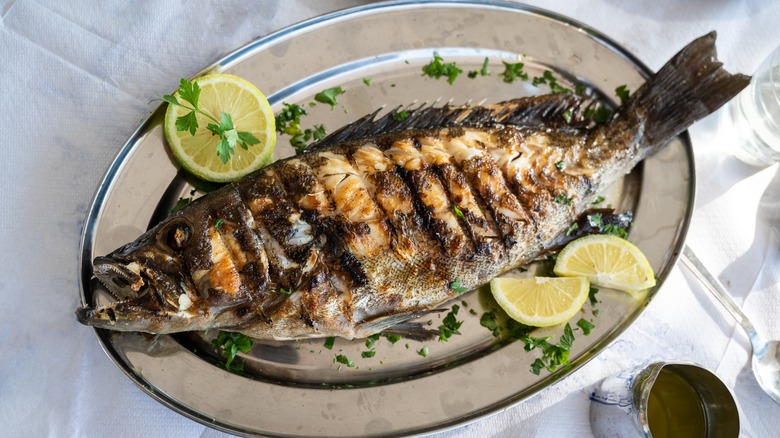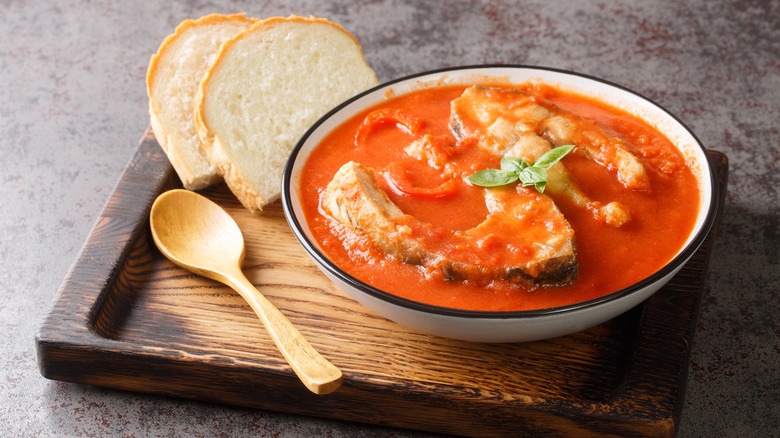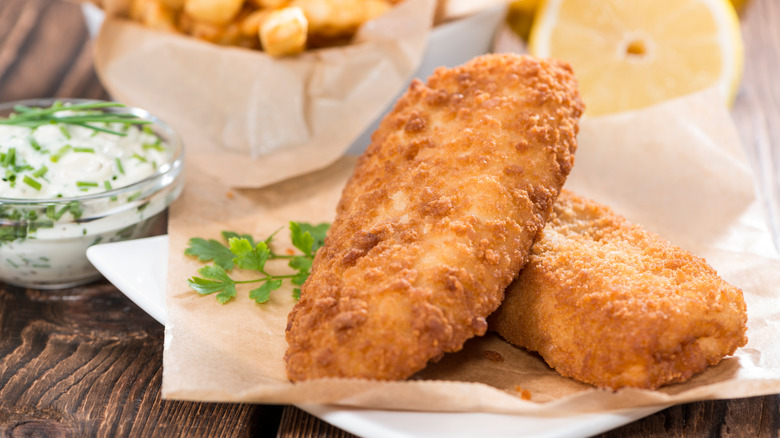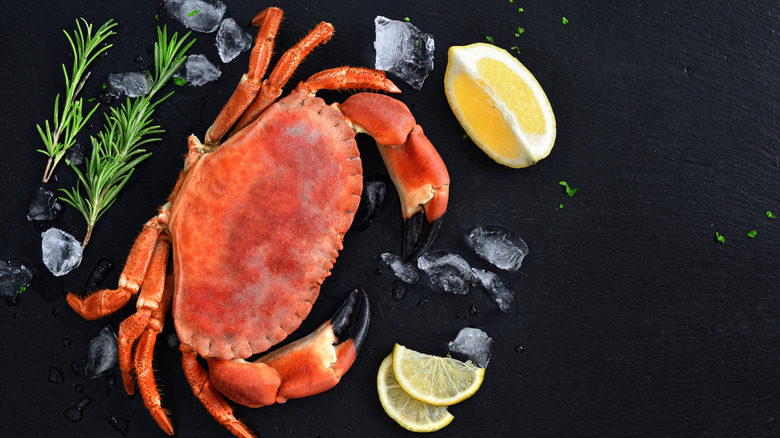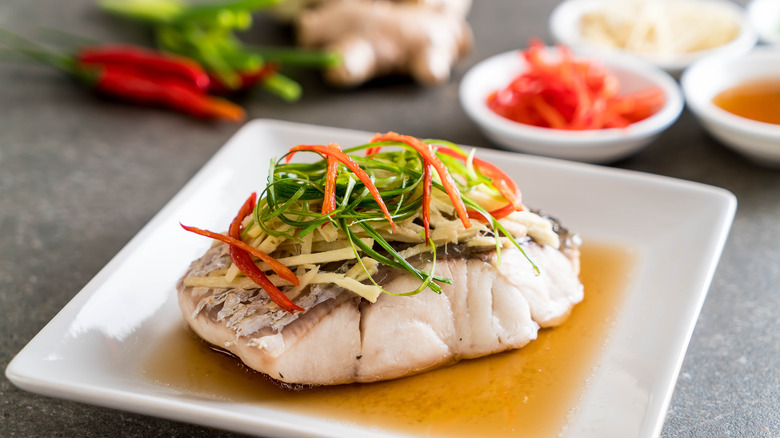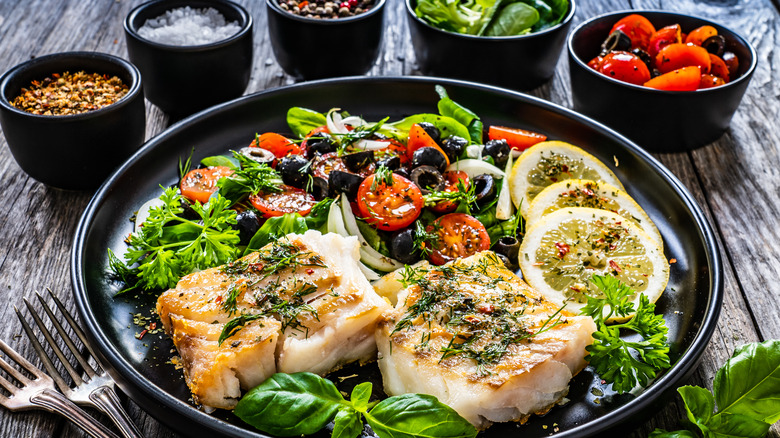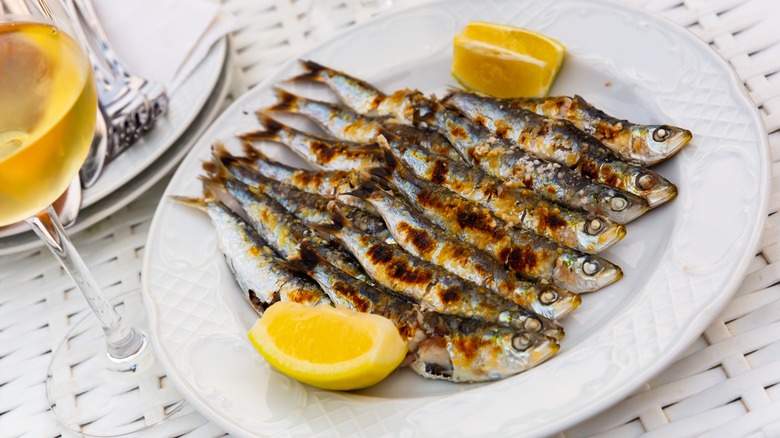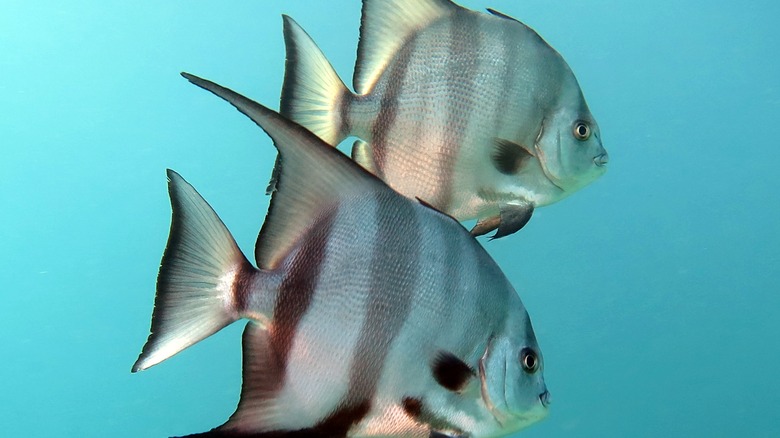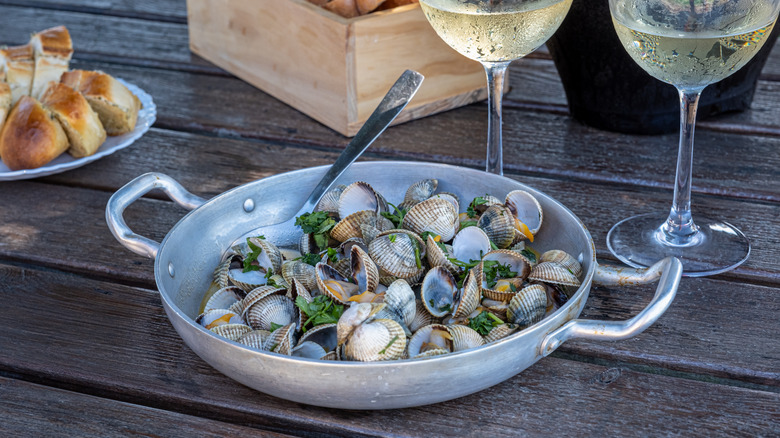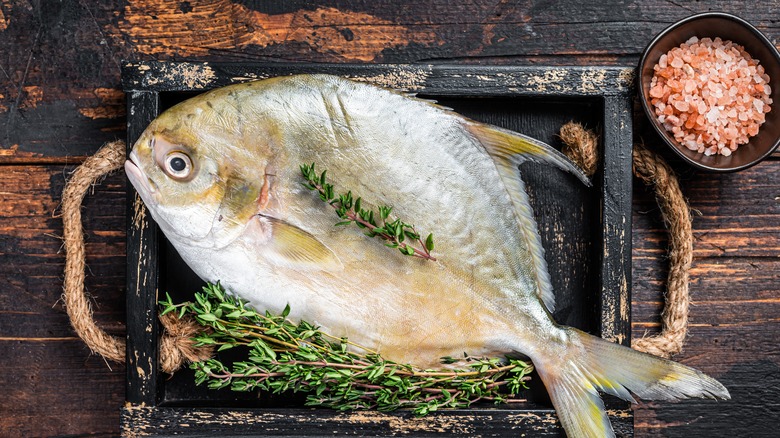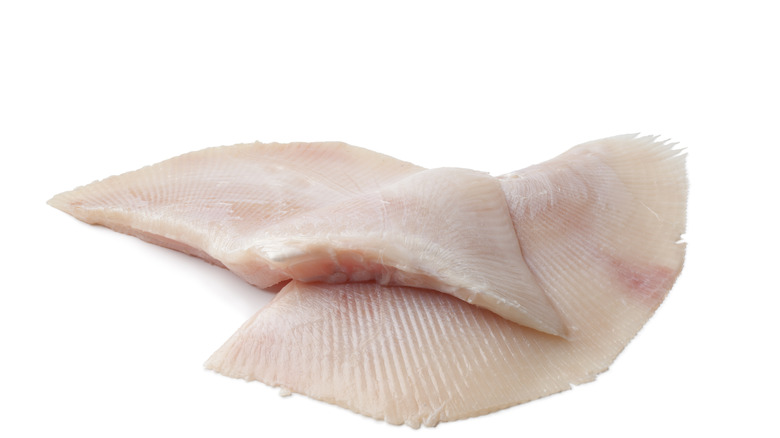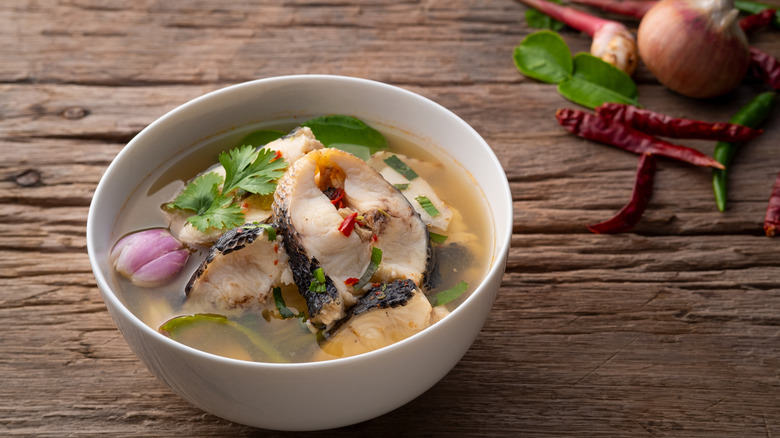You Need To Stop Overlooking These 12 Types Of Fish
Fish is a favorite of many Americans. When seafood is on the menu, old standbys like salmon and tuna quickly come to mind. While there's no shame in having a love for the classics, tunnel vision regarding the fish on your plate is not just limiting to your palate but also injurious to our oceans. According to The HuffPost, the list of seafood being overfished has risen due to several factors, including climate change, overconsumption, and environmental degradation. Leaning into underused fish, known as trash fish by eco-aware chefs, fisheries, and environmental protection agencies, may provide a solution to keeping our oceans sustainable.
Luckily, the ocean contains a multitude of seafood options for the adventurous, and there are more than a few underrated fish you should be cooking that culinary experts have already caught on to. USA Today points to chefs taking the lead in sustainability measures by adding underused fish to their menus and introducing diners to lesser-known seafood formerly considered too fishy or tasteless to eat. Smoking, spice rubs, and grilling help elevate the taste of these sorts of fish, while a chef's respect for seasonality means these fish are only added to the menu when their populations are highest after the spawning season.
Fortunately, you don't have to be a chef to make these changes. By looking to underused seafood, switching to a sustainable fish diet is easier and better for ocean life and the planet.
Carp aka Copi
Britannica describes carp as composed of several groups of aquatic earth-toned fish species raised mainly on farms in Eurasia and introduced to North America in the 19th century. These omnivorous fish spawn in abundance and are considered an invasive species that eat underwater plants and smaller sea life, wrecking local ecosystems. Simply put, eating carp helps promotes oceanic sustainability, but getting Americans to try carp has been challenging in the past due to their voracious bottom-feeder reputation.
This is the real reason Asian carp has been renamed "copi." According to Smithsonian Magazine, the Choose Copi initiative is led by the Illinois Department of Natural Resources (IDNR) and includes collaboration with over 30 distributors, retailers, processors, and restaurants across the U.S., trying to get more of us to eat these misunderstood fish.
Copi is comparable to a more savory tilapia with a firm texture and fresh yet mild flavor. This makes it perfect for almost any cooking method. Steaming, baking, roasting, grilling and pan frying are all great options for this versatile fish. Deboned, battered, and fried cuts of copi, accompanied by pickled red onions, chipotle mayonnaise, shredded cabbage, and avocado, can make for an incredible taco combination when wrapped in warm tortillas. Mince copi with brown rice, cilantro, and cumin, then refrigerate the mixture for 15 minutes until it hardens enough to shape into patties. Then deep-fry them at 350 F until golden brown for outstanding fishcakes. Or dip them in a simple tartar sauce and enjoy!
Dogfish
According to Britannica, dogfish are actually smaller-sized members of the shark family. The biggest problems caused by dogfish relate more to stealing fishermen's bait and damaging fishing nets than anything that happens in a Jaws movie. Spiny dogfish have spikey dorsal fins that are known to cause injury, and as per Telegram & Gazette, they have glands that release a non-lethal venom similar in intensity to stingrays.
As per NPR, while dogfish are plentiful on the East Coast, they haven't caught on in U.S. diets. As of 2017, as much as 99% of captured dogfish are shipped overseas for British fish and chips, French stews, and Italian grills. Not only are Americans missing out on dogfish's sweet, cod-friendly texture but also the opportunity to buy locally sourced fish that supports American suppliers — and the economy. That's slowly changing, as evidenced by the University of Massachusetts offering creative dishes like dogfish tacos and sushi to its student body.
According to CapeCod.com, restaurants in the region are making the most of the overabundance of dogfish. A local group of restauranteurs and fishermen called the Fishermen's Alliance launched an initiative — Pier to Plate — to make use of underused, local catch, including dogfish. You don't need to be a chef to do this at home. Just dredge strips of dogfish in an egg wash, then a mixture of flour, paprika, cayenne, and lemon zest before placing them in a deep fryer at 375 F for 3 minutes.
Atlantic Rock Crab
The Virginia Institute of Marine Science describes Atlantic rock crabs as tiny to midsized crustaceans — males can get up to 135 millimeters and females about 113 millimeters wide — that enjoy cold water environments. They can be found in both shallow as well as deep water and are sometimes swept up in lobster fishermen's nets. Their squat heart-shaped bodies are typically crimson or violet and, just like other crabs and lobsters, outfitted with a hard outer shell and front pincers.
Now that we know what rock crab is, how do you eat it? Most of the meat in Atlantic rock crab meat can be found in its front pincers or claws and has a hint of seawater and understated sweetness about it. To get to it, the crab should be placed in a pot of boiling water and served like lobster with fresh lemon wedges and creamy butter. Although there's not much protein to scrape out of the rock crab bodies, the shells can still be used to make a pretty authentic seafood stock base for flavourful soups and stews.
Industrious chefs like Executive Chef Tori Schumacher of The Ordinary restaurant in Charleston, South Carolina, are making magic with local crab. In a Charleston Magazine interview, Chef Schumacher details how The Ordinary kitchen starts with a well-seasoned pot of water and leads to rock crab claws chilled over ice with a bagnarotte sauce — a fancy French mayonnaise-based cocktail sauce — as an accompaniment.
Hogfish
Per the Ocean Conservancy, hogfish hang out along the ocean floor of the Western Atlantic Ocean, the Gulf of Mexico, and the Caribbean Sea and get their name from their pronounced pig-like noses. They can get up to 50 pounds — roughly the weight of five housecats — and the females can change their sex to male as they grow.
In a Gulfshore Life feature of Chef Everett Fromm of Naples, Florida restaurant Hogfish Harry, hogfish is described as similar enough to snapper to be nicknamed hog snapper. Chef Fromm creates dinner specials like pan-roasted hogfish with melted leeks, jumbo lump crab, blistered tomatoes for texture and acidity, and a light citrus beurre blanc sauce that adds to the dish without overpouring the natural flavor of the fish. The chef also suggests that, when sourcing fish from a fishmonger, ensure that the hogfish is fresh and smells like the ocean.
Of course, there are simpler ways to prepare hogfish at home that won't require anyone to blister tomatoes or enter a French culinary course to whip up a classy beurre blanc sauce. Salt both sides of a hogfish fillet and lay it skin-side down into a hot saute pan with oil. Once the fish appears translucent, flip it over, add butter and saute for 2 minutes. Pair it with a simple green salad or lay it over buttery mashed potatoes. Dinner doesn't get much quicker or easier than that.
Sablefish aka Black Cod
Sablefish, otherwise known as black cod according to NOAA Fisheries, is a sustainably managed and harvested fish in the U.S. that can grow over three feet long and gets its black cod moniker from its similar appearance to cod. They can live up to 90 years and are found chiefly in the northeastern Pacific Ocean, from Mexico to the Gulf of Alaska, as well as the Aleutian Islands and the Bering Sea. In terms of sustainability, this is a great choice for ethical pescatarians concerned about overfishing because its population is so well-regulated in the U.S.
Perhaps one of the most sought-after sablefish dishes to make a culinary mark in America is Nobu's black cod with miso dish. When dining at Nobu, a place where the high cost of the experience aligns with the top-notch quality of the food, it should be no surprise that the dish has made a huge splash among diners. However, if you're lacking the big bucks to dine at Nobu or the time to make your three-day miso marinade, pan-seared black cod with morels and asparagus offers a simpler sauteed vegetable pairing with fast pan-seared sablefish fillets cooked in 15 minutes.
Sardines
Sardines are another great fish everyone should stop overlooking, not just because they taste amazing but because this underutilized fish is also extraordinarily healthy. According to Healthline, between the omega-3 fatty acids that may reduce heart disease, blood clots, and high blood pressure, the exposure to vitamins B-12 and D for energy and healthy bones, necessary minerals, and high protein content, it seems almost ill-advised to ignore sardines in your diet. Even better, if the threat of mercury in fish is a major area of concern, LiveStrong provides some assurance that the mercury level of sardines is low because they only eat plankton and not other fish.
While talking about making mimosas with Selena Gomez, "Top Chef" finalist Chef Adrienne Cheatham gushed about her love of grilling fresh sardines — as opposed to in a can — with lemon and olive oil. Chef Cheatham believes that fresh sardines have a different flavor profile from the canned variety and don't need much love to get a wonderful natural flavor out of them. With smaller sardines, Chef Cheatham suggests sprinkling a little flour over them and frying them whole in oil. Add salt and pepper to taste, and you're done.
Atlantic Spadefish
The Atlantic spadefish, according to SeaWorld, can be found in the Western Atlantic and tropical to subtropical waters. Spadefish have black stripes across sliver frames with shapes reminiscent of the spades hand in a deck of cards — hence the name — and can travel in schools of up to 500 fish. However, they could have just as easily been called leaf fish based on their practice of camouflaging themselves by floating along like leaves in coastal waters.
Spadefish is a mild-tasting, flakey fish that should be filleted by a skilled fishmonger, skin off or on. Baked spadefish fillets require a preheated oven at 350 F and a liberal sprinkling of good sea salt and pepper on both sides of the fish. Lay the fillets out on a baking sheet or oven-resistant pan. An olive oil, paprika, and lemon bath is all the marinade you need, and it requires no extended waiting time. The acid in the lemon juice will cook the fish like a ceviche if it sits too long, so get them in an ovenproof pan or baking dish and into the oven as soon as possible. In 20 to 25 minutes, pull the fish out of the oven and enjoy this citrusy, smoky marvel in spades.
Basket Cockles (Nuttall's or Heart Cockles)
No matter what you call them, these little clams are sure to warm your heart. According to the Washington Department of Fish and Wildlife (WDFW), the ochre or brown clams classify as mollusks and can get to about 5.5 inches around. They burrow themselves one or two inches into gravel or beach sand with a digger foot that also comes in handy for leaping away from natural predators. The National Park Service has rules around who gets to harvest cockles and what time of year they're allowed to do it, so don't walk around public lands collecting cockles. However, if a decent fishmonger exists in your area, you shouldn't have to.
There are several different types of clams to be enjoyed; cockles, which are great raw or moderately steamed with a pat of butter and a freshly squeezed spritz of lemon, are lesser known. The New York Times described how Chef Sean Rembold, the owner of Inga's Bar in Brooklyn, NYC, presented a fisherman stew in a fiery tomato broth with mussels, cod-like chunks of hake fish, and last but not least, cockles. Sounds like a great idea to us.
At home, sauté three chopped garlic cloves in olive oil over medium heat. Add 3 pounds of cockles and ½ cup of white wine to the pan. Cook for about 5 minutes or until all the shells open, and serve the cockles and broth in a bowl with some crusty bread and lemon wedges.
Butterfish
Butterfish as skinny, metallic-colored fish found in sub-tropical and tropical waters with tiny mouth openings, forked tails, and lone dorsal fins (via Britannica). The main butterfish commonly fished are caught in the Atlantic, called harvest fish; butterfish from the Pacific are called Pacific pompano, Pampus argenteus, and rock gunnel, and can also be considered a member of the family.
In an interview with the Michelin Guide, Chef Roh Younghee of Michelin Star restaurant Poom in Seoul, South Korea, writes that she prides herself in cooking healthy meals that change with the seasons. To illustrate this, Chef Younghee uses a Korean red pepper paste called gochujang to create a gochujang-braised butterfish with traditional Korean elements like ginger, rice wine, soy sauce, sesame oil, and gochujang.
Lean into the Asian influence at home with miso butterfish. With an oven set to around 400 F, melt a few tablespoons of butter on a skillet over medium heat and mix in miso, sugar, sriracha, a few crushed clove of garlic with a generous nob of grated ginger, and panko crumbs. Place the butterfish fillets skin-side down on a baking sheet and use a spoon to slather the fillets with the miso butter gently. Roast the fish for about 15 to 17 minutes until the butterfish is firm. By setting the broiler to low for about 5 minutes, you can turn the panko a golden brown and add a decadently textured crust. Serve with rice, and enjoy.
Skate
Marine organization American Oceans loosely describes skate fish as light pink, flat-bodied and bat-winged fish — quite similar to stingrays in appearance with the exception of a stinger on their tails — and actually very edible despite their odd, slimy appearance. They are coveted as a delicacy in other parts of the world and can be found on restaurant menus, particularly in Europe and the Mediterranean. Although all the meat is in the wings, the versatility of its sweet, scallop-like texture and taste allows for skates to be fried, roasted, and grilled without falling apart like other flakey white fish. However, skate may be a little too popular, as it's also considered an endangered sea life.
However, even with all those options for cooking, skate is an overlooked seafood option in the U.S. While they are fished in the mid-Atlantic and the waters off of New England, they are more likely to end up as bait for lobster and crab than on anyone's dinner table. Skates have sharp spikes on their underbellies, degrade quickly if not stored properly, and can secrete ammonia which can make diners sick. So although the fish are tasty, cheap, and available, get a trusted fishmonger to source quality skate with spikes removed. After that, we love this seafood spin on classic pub fare, buffalo skate wings with celery root rémoulade. Although particular, it's a fantastic way to go pescatarian for the next big game, or just anytime you're game to try something new.
Snakehead
According to the U.S. Department of the Interior (USGS), The two types of snakeheads, channa, found mainly in Asia and South Asia, and Parachanna, from Africa, are water-breathing, invasive species with females known to carry as much as 50,000 eggs. They are highly disruptive to local ocean ecosystems and fishing in general. The invasive species were introduced to the U.S. (before being banned by the government) by aquarium hobbyists and by people who buy and release animals from pet stores, live food markets, and restaurants. However, they can still be purchased for eating as long as they are deceased and on ice.
According to The Baltimore Sun, snakeheads are thick and meaty with an off-sweet flavor and eel-like texture. Chefs in Maryland have figured out how to make the most of the invasive species in their kitchens. In a feature in Baltimore Magazine, Chef Zack Mills of True Chesapeake Oyster Co. dredges them in flour and buttermilk to create a chicken-fried iteration of snakefish. From our perspective, this is a good way to go. The firm texture of snakeheads means that the fish will hold up to frying, while a buttermilk batter of spices like cayenne, salt, thyme, and paprika can morph the slightly sweetened taste into something a bit more rounded. When cooked golden brown, even the viscous eel texture becomes something a bit more aligned with traditional dining experiences.
Tautog aka Blackfish
According to On The Water, tautog is a shaded color fish — hence the "blackfish" nickname — found in Atlantic saltwater environments that can grow up to three feet long and tip the scales at over 20 pounds. Although described as hard on the eyes, what these bottom-feeding fish lack in looks, they make up for in a great flavor close to red snapper.
In Bluedot Living Magazine, the 2019 author of The Joy of Seafood, Barton Seaver, suggested tautog works well in stews and is sufficiently hardy to withstand broiling. In fact, if you know how to grill a whole fish, tautog is versatile enough to work cooking it this way and won't fall apart on you. That opens up a world of possibilities for the home cook that wants to try something new with a familiar taste.
Take your tautog fillets to the Mediterranean with this dinner idea. Preheat your oven to 425 F. Line a baking sheet with tin foil and place 1 pound of fillets on the sheet. Sprinkle both sides of the tautog with smoke paprika, salt and pepper, and grated parmesan cheese to taste. Bake for 7 to 10 minutes until cooked and the outer crust is crunchy. Dip these baked parmesan tautogs into a quality marinara dipping sauce and enjoy with a refreshing glass of pinot grigio, sauvignon blanc, or chardonnay.
